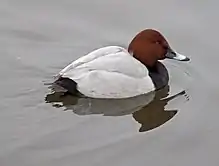Common pochard
The common pochard (/ˈpɒtʃərd/; Aythya ferina) is a medium-sized diving duck. The scientific name is derived from Greek aithuia an unidentified seabird mentioned by authors including Hesychius and Aristotle, and Latin ferina, "wild game", from ferus, "wild".[2]
| Common pochard | |
|---|---|
 | |
| Male | |
.jpg.webp) | |
| Female | |
| Scientific classification | |
| Kingdom: | Animalia |
| Phylum: | Chordata |
| Class: | Aves |
| Order: | Anseriformes |
| Family: | Anatidae |
| Genus: | Aythya |
| Species: | A. ferina |
| Binomial name | |
| Aythya ferina | |
 | |
| Range of A. ferina Breeding Resident Non-breeding | |
| Synonyms | |
|
Anas ferina Linnaeus, 1758 | |
Description
The adult male has a long dark bill with a grey band, a red head and neck, a black breast, red eyes and a grey back. The adult female has a brown head and body and a narrower grey bill-band. The triangular head shape is distinctive. Pochards are superficially similar to the closely related North American redhead and canvasback.
Females give hoarse growls. Males have whistles cut off by a final nasal note aaoo-oo-haa.
 Male common pochard, London, UK
Male common pochard, London, UK Diving, Delta del Llobregat, Barcelona
Diving, Delta del Llobregat, Barcelona
Distribution and habitat
Their breeding habitat consists of marshes and lakes with a metre or more water depth. Pochards breed in much of temperate and northern Europe and across the Palearctic. They are migratory, and spend winter in the south and west of Europe.
In the British Isles, birds breed in eastern England and lowland Scotland, in small numbers in Northern Ireland with numbers increasing gradually, and sporadically in the Republic of Ireland, where it may also be increasing. While uncommon, individuals are also occasionally seen in the south of England, and small populations are sometimes observed on the River Thames. Large numbers stay overwinter in Great Britain, after the birds retreat from Russia and Scandinavia.
Ecology

These are gregarious birds, forming large flocks in winter, often mixed with other diving ducks such as the tufted duck, with which they are known to hybridise.
These birds feed mainly by diving or dabbling. They eat aquatic plants with some molluscs, aquatic insects and small fish. They often feed at night, and will up-end for food as well as the more characteristic diving. According to the article 'Patterns in the diving behaviour of the pochard, Aythya ferina: a test of an optimality model' Pochard's have a behavioral preference when it comes to their feeding patterns. This behavioral preference is that Pochards prefer shallower water in comparison to deeper water even though the food concentration in deeper water may be higher.
In number of countries the population of Common Pochard is decreasing mainly due to urbanization of the natural habitats and their transformation, as well as due to overhunting.[3] The pochard is one of the species to which the Agreement on the Conservation of African-Eurasian Migratory Waterbirds (AEWA) applies.
References
- BirdLife International (2015). "Aythya ferina". IUCN Red List of Threatened Species. 2015: e.T22680358A82571892. doi:10.2305/IUCN.UK.2015-4.RLTS.T22680358A82571892.en.
- Jobling, James A (2010). The Helm Dictionary of Scientific Bird Names. London: Christopher Helm. pp. 64, 158. ISBN 978-1-4081-2501-4.
- Common Pochard (Aythya ferina) in Armenia. 2017. In online publication: "The State of Breeding Birds of Armenia". TSE NGO, Armenian Bird Census Council. Retrieved on 10 October 2017.
Further reading
- Carbone, C.; Houston, A.I. (August 1994). "Patterns in the diving behaviour of the pochard, Aythya ferina: a test of an optimality model". Animal Behaviour. 48 (2): 457–465. doi:10.1006/anbe.1994.1259. S2CID 53186922.
External links
| Wikimedia Commons has media related to Aythya ferina. |
| Wikispecies has information related to Aythya ferina. |
- Pochard at RSPB Birds by Name
- BirdLife species factsheet for Aythya ferina
- "Aythya ferina". Avibase.

- "Common pochard media". Internet Bird Collection.
- Common pochard photo gallery at VIREO (Drexel University)
- Interactive range map of Aythya ferina at IUCN Red List maps
- Audio recordings of Common pochard on Xeno-canto.
